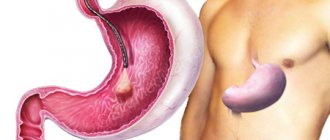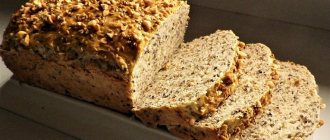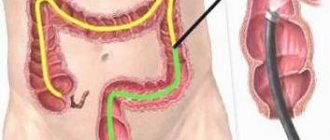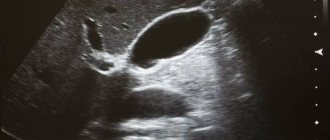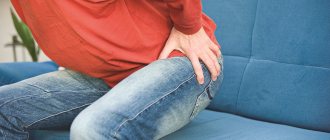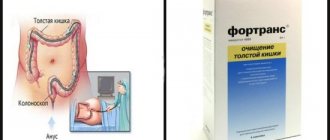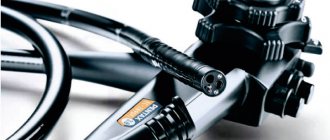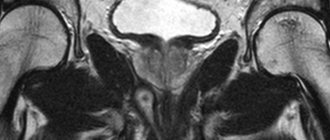Full text of the article:
Colon cleansing with enemas and castor oil is one of the traditional methods of preparing for colonoscopy.
Three days before the test it is necessary to exclude from the diet:
- Iron supplements and activated carbon
- Products containing small seeds: grains, grapes, kiwi, poppy seeds, sesame seeds, cumin, apples, oranges, tomatoes, berries.
- Beets, borscht, greens.
- Substances that can stain the intestinal mucosa
If you suffer from constipation, you need to take the laxatives you usually use every day. You can even slightly increase their dose.
If you suffer from constipation and have not taken laxatives, you must start taking laxatives 3 days before the procedure.
Note:
self-preparation only with enemas (without castor oil) at home is not effective! You will not be able to prepare sufficiently, the research may be painful and not informative!
Classic preparation for colonoscopy:
- On the day before the test, eat only liquid soup for lunch.
- At 15:00-17:00 hours, take 40-50 grams of castor oil.
- In the evening at 20:00 and 21:00, do 2-3 cleansing enemas of 1 liter of cool (about 20 degrees) water.
- Dinner should be light: yogurt, soft cottage cheese.
- On the day of the examination, you can have a light breakfast in the morning, only if the examination is before 11:00, you can drink any liquids. If the test is later than 11:00, only liquid porridge or cottage cheese is allowed. food masses may end up in the colon by the time of the study.
- On the morning of the study, two cleansing enemas of 1 liter of cool water.
If your weight is more than 80 kg, you can increase the number of cleansing enemas.
Contraindications
Despite the indicated safety of enema procedures, contraindications should be taken into account.
Flushing the intestinal tract allows you to remove dirt, waste, and toxins from the canals. With frequent washing, beneficial microorganisms are also removed along with harmful substances, and the local microflora is completely washed out. Mineral components also leave: for example, calcium. As a result of calcium leaving the body, arrhythmia and other difficulties with the cardiac system develop.
In what cases will an enema cause negative reactions:
- The presence of purulent diseases inside.
- Ulcers, fissures, neoplasms in the anus and large intestine.
- Development of purulent infection inside. It occurs when the integrity of the intestine, in particular the appendix, is compromised, and the contents, along with pus, reach the surface of other organs.
- Inflammation of the appendix of the cecum - appendicitis.
- Internal bleeding that opens in the stomach or intestinal tract.
- Hemorrhoids provoke bleeding.
- Frequent prolapse of the intestine into the anus.
How to do an enema correctly?
To get the proper effect, it is important to buy the right enema - Esmarch's mug (with a lock).
The significant disadvantages of this method include the fact that it is quite difficult to carry out the procedure without outside help. You will have to simultaneously inject the liquid, control the flow, and then hold it in the intestine for several minutes, while simultaneously holding the tip in the desired position, then remove the tip without getting up and close the tubes if the water is not completely introduced into the intestine. Therefore, think about an assistant or immediately switch to modern methods of preparation with drugs.
Follow the instructions carefully:
- It is necessary to fill the Esmarch mug with 1-1.5 liters of cool (about 20 degrees) water. Cold water increases intestinal motility and bowel cleansing will be more effective.
- Then you need to hang the mug at a height of at least 1.5 meters from the floor.
- Open the latch/lock and wait until all air leaves the system and only water flows - lock the latch/lock.
- Lubricate the tip of the tube with Vaseline or a special cream
- It is optimal to lie comfortably on your left side
- Insert the tube into the anus
- Open the latch/lock at the tip.
- We introduce the entire volume of liquid from Esmarch's mug.
- Roll over onto your back and lift your pelvis.
- Then slowly roll over onto your right side, breathe deeply several times, then relax.
- Turns from side to side can be repeated several times. If you have the urge to defecate, be patient for 1-2 minutes and calmly go to the toilet.
- We repeat the cycle.
It is important that the method of preparation for a colonoscopy is recommended by the doctor who ordered the study, since only he knows exactly the initial state of your body and can prescribe the optimal/acceptable method of preparation.
Tips for first timers
There are many people who suffer from a fear of enema procedures, considering them dangerous and painful. The danger of an enema lies in its frequent use. It is recommended to use forced bowel cleansing no more than once every 3 days and no longer than 3 weeks. The restriction is set because nutrients, minerals, and beneficial bacteria are washed out.
When studying the question of whether it is painful or not, it should be said that if recommendations, instructions are followed and there are no contraindications, the manipulation is considered painless. To ensure a smooth insertion of the tip with the tube, lubricate the tip and anus with Vaseline or other fat.
Scheme for colon cleansing with enemas
There is a developed scheme for performing cleansing enemas before starting any treatment or in parallel with it. Cleansing with enemas according to the scheme cleanses the body of toxins. Before starting treatment for any chronic skin disease, a cleansing enema is necessary.
Colon cleansing with enemas is carried out according to the following scheme
| A week | Frequency of enemas |
| 1 | Weekly |
| 2 | In one day |
| 3 | After two days |
| 4 and all subsequent ones | Once a week |
When and to whom can you give an enema?
Pregnant women are given an enema immediately before giving birth.
The essence of a cleansing enema is the desire to “help” the body on its own, in the most natural way for it to get rid of the toxins clogging the intestines.
Abuse of such a procedure can be dangerous to health, so it is usually carried out as prescribed by the attending physician:
- with long-term (from two days or more) stool retention;
- in case of severe intoxication of the body with harmful chemicals or drugs; sometimes - after eating poor quality food;
- for hygienic purposes (for pregnant women - immediately before childbirth, and in other cases - shortly before surgery);
- for constipation accompanied by fever (especially important for infants);
- immediately before examination by a radiologist, endoscopist or proctologist;
- before starting a long session of therapeutic fasting.
You can give such an enema yourself, at home. You just need to purchase everything you need for this procedure at your nearest pharmacy.
Indications and contraindications for the procedure
Indications for the use of enemas depend on their type. Types of enemas and their administration, as well as indications for use are as follows:
Cleansing
- The procedure is performed before childbirth, abortion or surgery.
- Stool disorders or prolonged absence.
- In case of food poisoning.
- Before endoscopy.
- A cleansing enema is used before various diagnostic procedures.
Medical
- Local beneficial effect on the intestines and other organs of the digestive system.
- General therapeutic effect on the human body.
- Use when administering medications through the oral cavity is contraindicated.
- Used when the large intestine is inflamed.
Laxative
- If necessary, cleanse the intestines.
- When the effectiveness of a cleansing enema is low.
- With extensive swelling.
Nutritious
- Used when necessary to provide the body with nutrients.
- In case of dehydration.
- In the absence of the possibility of receiving nutrients or medications through the mouth.
Enema is a popular therapeutic procedure, but it also has a wide range of contraindications. Enema is strictly contraindicated for the following diseases:
- Presence of bleeding from the digestive system.
- Painful abdominal cramps of uncertain nature.
- Benign or malignant neoplasms in the rectal cavity.
- Hemorrhoids accompanied by bleeding.
- Intestinal infections and inflammatory processes in the rectal area.
It should be remembered that such a medical procedure as an enema should be prescribed exclusively by a doctor. You should not self-medicate, as improper use of an enema can cause serious harm to the body.
Types of operations that require a cleansing enema to prepare
The types of operations differ depending on the specialization of the surgical hospital. Let us give examples of the most common pathologies.
Stomach and intestinal surgeries:
- performing one type of gastric resection for ulcers or cancer with the formation of an anastomosis between the remaining part of the stomach and the intestinal loop;
- elimination of intussusception (wedging of part of the intestine into an adjacent area), obstruction, resection of the intestinal segment in Crohn's disease with excision of necrotic tissue;
- appendectomy;
- abdominal and inguinal hernias in case of strangulation as an emergency, for plastic surgery and suturing of the extended ring - as planned;
- excision of a tumor of the large or small intestine, removal of the stoma to the skin, followed by the stage of plastic surgery;
- cholecystectomy;
- elimination of developmental abnormalities in children.
How to properly prepare for a visit to a proctologist?
A proctologist is a pre-determined doctor whom you should not be ashamed of.
Any trip to the doctor requires compliance with the rules of preparation for the visit. Even when planning a trip to the therapist to measure your blood pressure, you need to at least brush your teeth and comb your hair. Visiting specialists requires a more thorough approach. Before you come to see a proctologist, you will have to empty the intestines of the contents. This is done in two ways:
- Mechanical colon lavage using an enema
- Use of special laxatives
If the patient suffers from severe pain, then it is better not to cleanse the intestines on your own. The doctor will conduct an initial and manual rectal examination and prescribe painkillers and anti-inflammatory drugs. After the pain is relieved, the proctologist will conduct the necessary instrumental examination.
What do you need to buy?
For an enema at home, you need to purchase a rubber bulb.
To properly carry out a procedure such as an enema at home, you will need to purchase:
- pharmacy set with Esmarch mug;
- a rubber “bulb” with a volume of about 500 ml, equipped with a soft tip (such a “tool” is much more convenient for giving an enema to a child, especially when it comes to infants);
- oilcloth (the bed on which the procedure will be performed will need to be covered with something waterproof);
- Vaseline (it will be needed to lubricate the enema tip, which, in turn, is necessary for more convenient insertion into the rectum);
- soap without chemical fragrances (ideally, baby or laundry soap).
Here it is worth talking in more detail about what Esmarch’s mug is. At first glance, this is an ordinary rubber vessel-reservoir (today, however, there are also options made of glass or even enameled).
Devices may vary in shape. The standard model most often resembles a two-liter heating pad with a neck on one side and a small hole (about 1 cm in diameter) for a hose on the other.
As a rule, Esmarch mugs are sold complete with special hoses. The latter have a length from a meter to one and a half and are equipped with a special tap for adjusting the speed and volume of liquid supply. The hose ends with a special neat tip made of plastic, glass or hard rubber. This product can be purchased fully equipped at any pharmacy.

